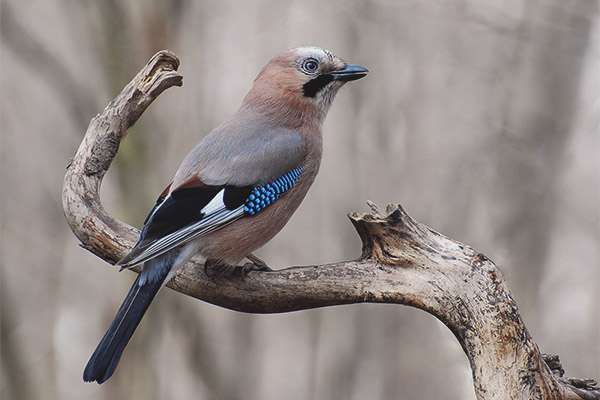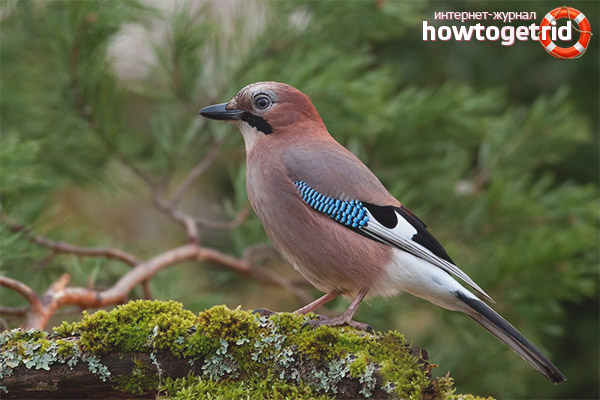The content of the article
Jay is a bright representative of the passerine family. The light festive plumage of the bird became its main distinguishing feature. In addition, it is characterized by good adaptive properties. This is what allows some birds not to fly away to warm lands during the migration period, but to stay in the winter and find refuge from the cold weather under the canopy of the tree. Jay is picky about food, occasionally attacks other representatives of his passerine family.
There are several versions of the origin of the name of the bird. According to one of them, the name "jay" was derived from the word "shine". Probably, the bird has long since pleased the beauty and brightness of its plumage, and therefore received such a name. Interestingly, the "jay" is a diminutive form of the original name of the bird "soy".
Often jays are confused with cuckoos due to similar variegation of plumage, body shape and size. It is possible to distinguish the birds from each other due to the characteristic features of each species.One of these is the imitative abilities of jays, which are very appreciated by ornithologists. Yielding to the parrots, they still have an advantage over the cuckoo in this difficult task, demonstrating the good mental abilities of birds.
Description of the species
Jays do not differ in large size. The length of the individual body does not exceed 40 cm. Thus, a rare representative of this species is able to surpass the familiar dawns of each. The plumage of the bird is smooth and consists of small individual feathers. The wingspan of an adult bird is capable of reaching 50 cm. This fact explains the well-known paradox: the jay sitting on a branch seems small, but as soon as it soars, the idea of its size changes immediately. Feathery weight varies from 170 g to 200 g. Paws are characterized by good length. Claws help birds to cling to tree branches. The sharp and short beak has a massive nadklyuve.
The color of the eyes of adult jays is light blue; in the early age birds are usually brown. Until now, ornithologists have not figured out the reason for such changes. One of the versions explaining the age-related change in the pigmentation of the iris of the eye is equating it with the signal of puberty of the bird and its readiness to enter into the mating season.
As noted earlier, representatives of this species of birds are able to imitate various sounds, in particular those that are issued by other birds living in the neighborhood. Hence her second name, Jay Mockingbird, which became known from the novels of Susan Collins. Cases when the bird imitated the person, repeating some words are recorded.But such attempts by birds of this species did not differ in clarity, which is characteristic of parrots.
Habitat and behavior of birds
Jays are very common birds. The high level of adaptability and excessive fearfulness forced the representatives of this species to spread widely throughout the European continent. Thus, the largest bird populations were found in Russia, France, and the Baltic states. These territories are not limited to jays and settled on the Chinese and Korean lands. These same biological factors influenced the fact that, being a mainland bird, the jay found a place to stay on various islands, including on Sakhalin.
Typically, birds of this species are predominantly sedentary and prefer to settle in the forests. The desert steppes repel jays, because there it is more difficult for them to find food and it is easier to get into the hands of a predator.
Every year, birds leave northern habitats and migrate towards the South. Such behavior of jays is caused by the need to shelter from freezing weather. If climatic conditions are not characterized by pronounced seasonality,as in the southern part of Eurasia, jays do not make such flights.
What eats?
Representatives of this species of birds differ in their acumen, as evidenced by their habit of making food stocks. For example, in the autumn months one bird is able to set aside more than 3 kg of acorns on a “black day” In addition to this delicacy, bright birds love pine nuts, which explains the high probability of meeting large populations of jays in the growing places of oaks and cedars.
What else is included in their diet? Jays eat cereals, nuts, various insects and snails. If the population of jays lives near a reservoir, then birds can eat mollusks or small amphibians. Forest-steppe jays eat rodents, lizards, as well as small birds and their eggs or chicks. For this, jays are often shot by hunters, believing that they are harmful. But, in fact, the benefit of this species is much greater, since the gluttony of birds in summer leads to the destruction of a large number of plant pests: insects and rodents. Natural enemies of the jays are often attacking them hawks, ravens, martens
Usually jays eat a lot in spring and summer to form fatty deposits, which are necessary for the bird in winter. In early September, birds enter the mode of stockpiling. Old junk stumps or hollows of trees are used as jay stores. In addition to using their stocks, birds often “steal” from neighbors. Ornithologists record the fact that birds love to eat agricultural products. For example, jays eat small tubers of potatoes, carrots and beetroot.
The developed jay brain allows them to look for various ways that make bird life easier. A similar example is their visit to anthills. Birds do this by breeding in parasite plumage or as a preventive measure. Formic acid, released by insects in order to chase away the bird, kills unwanted parasitic organisms. Another illustration of the intelligence of birds is their custom of grouping under the branches of coniferous trees in the winter, which helps to keep warm.
Bird Breeding Features
The mating season of jays begins in the first months of spring, when birds are looking for partners.At this time, they prefer to move to the growing area of dense forest, near natural water reservoirs. Gathering in large flocks, the jays scream and arrange battles. This process takes about 7 days. As a result, couples are formed that are looking for a place to house a nest, for example, a stable female.
The birds nest is usually shaped like a shallow bowl. Its volume is twisted from strong rods, in turn, the inside is lined with leaves or grass. There, the female lays from 4 to 7 eggs, but they hatch by both birds alternately for 15-17 days. The eggshell is green, yellow or brown. Hatching juveniles of jays have a good appetite, so parents are forced to look for food for them all day. Often the chicks die from hunger. If there are many insects, the birds gradually grow and grow stronger.
Interesting Facts
- In the southern part of Siberia, a new variety of jays, distinguished by its color. In addition, special birds are migratory.
- For three summer months, the jays prefer to keep a distance with respect to human settlements, settle in forests or groves, where they manage to find the required amount of food.In winter, birds, on the contrary, arrive in the city, because they need feed, which is not easy to find in their natural environment this season.
- City jays do not make stocks for the winter. Birds find enough food in park feeders, as well as in garbage cans and bins. If they find not enough, they steal the food stored on the balconies.
- Jay chicks in the first days of life need a large amount of protein to form a skeleton, so the adults feed them with insects. Only having got stronger, birds switch to vegetable food.
Video: jay (Garrulus glandarius)













To send